Details
-
Type:
 Bug
Bug
-
Status: Closed
-
Priority:
 Major
Major
-
Resolution: Won't Fix
-
Affects Version/s: 2.0.0
-
Fix Version/s: 2.0.1
-
Component/s: ICE-Components
-
Labels:None
-
Environment:ICEfaces 2
-
Assignee Priority:P1
-
Workaround Exists:Yes
-
Workaround Description:
Description
http://www.icefaces.org/JForum/posts/list/18300.page
http://www.icefaces.org/JForum/posts/list/17692.page
http://www.icefaces.org/JForum/posts/list/18306.page
http://jira.icefaces.org/browse/ICE-3983?focusedCommentId=29886&page=com.atlassian.jira.plugin.system.issuetabpanels%3Acomment-tabpanel#action_29886
From the forums threads, and JIRA comment, it appears that several code paths in Tree and TreeNode are running, when Tree.rendered=false or TreeNode.rendered=false, leading to garbled display, and invalid application state.
http://www.icefaces.org/JForum/posts/list/17692.page
http://www.icefaces.org/JForum/posts/list/18306.page
http://jira.icefaces.org/browse/ICE-3983?focusedCommentId=29886&page=com.atlassian.jira.plugin.system.issuetabpanels%3Acomment-tabpanel#action_29886
From the forums threads, and JIRA comment, it appears that several code paths in Tree and TreeNode are running, when Tree.rendered=false or TreeNode.rendered=false, leading to garbled display, and invalid application state.


I can reproduce the issue with ice:treeNode having rendered=false, and the navigation lines showing. Refer to
ICE-3983and it's second attached image.